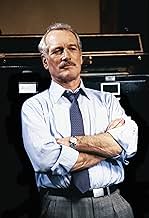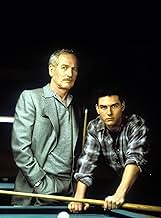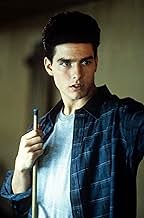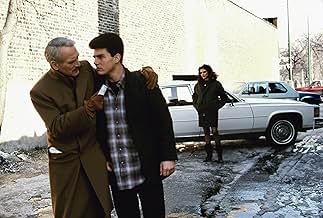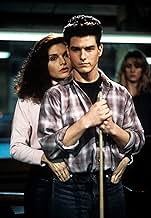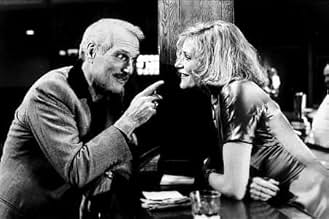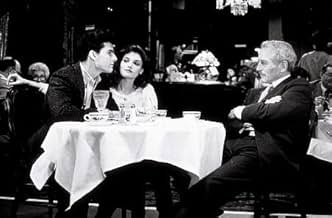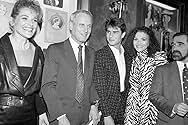Fast Eddie Felson teaches a cocky but immensely talented protégé the ropes of pool hustling, which in turn inspires him to make an unlikely comeback.Fast Eddie Felson teaches a cocky but immensely talented protégé the ropes of pool hustling, which in turn inspires him to make an unlikely comeback.Fast Eddie Felson teaches a cocky but immensely talented protégé the ropes of pool hustling, which in turn inspires him to make an unlikely comeback.
- Director
- Writers
- Stars
- Won 1 Oscar
- 3 wins & 10 nominations total
- Director
- Writers
- All cast & crew
- Production, box office & more at IMDbPro
Featured reviews
Paul Newman reprised his role of Eddie Felson from "The Hustler" (1961), on all short lists of great movies, to star in "The Color of Money", a worthy sequel in the way "Rocky II" was to "Rocky" -- not a great movie, but very good.
Eddie, advancing in years, has apparently left the hustling circuit for a more respectable job as a liquor wholesalesman. On his route, he encounters a brash, obnoxious pool shark named Vincent (Tom Cruise) and his girlfriend (Mary Mastrantonio). Vincent has the talent, but not the brains or knowledge, to be another great hustler, so Eddie, his desire for the circuit reignited, offers to stake Vincent and teach him the ropes, in exchange for a substantial piece of the winnings. At first, Vincent's ego and obnoxiousness threaten his development, but he soon learns all of Eddie's tricks -- and a few of his own. By the time of the big tournament at the end of the movie, Eddie and Vince have split ways -- and find themselves on a collision course.
I just realized that "The Color of Money" is my favorite Tom Cruise movie, but not my favorite Paul Newman movie (which could well be "The Hustler"). I re-viewed this movie recently after a long discussion with some friends about the difference between a movie star and an actor, and the few living legends that are both (besides Newman, I'd include Jack Nicholson and Robert de Niro). As always, Newman, even with such a huge public persona, disappears into the role of the middle-aged grifter, heartbroken how far his game has fallen in the days since he left the pool hall circuit. But he also makes the other performers around him shine. Cruise's trademark cockiness shines through in Vincent. Besides Mastrantonio, one of my favorite actresses Helen Shaver turns in a nice performance as Eddie's girlfriend, and Forest Whitaker first appeared on my radar in his short time on screen.
The other star of the movie is the game. While Scorsese didn't make his movie into the character study of "The Hustler", he uses the pool tables and balls as a medium for many artistic scenes. If you are someone who enjoys looking at beautiful movies, you won't be disappointed. And there might even be some real pool players -- you never know...
The story is good, not great. "The Color of Money" is not cut from the same felt as "The Hustler", and does not try to be. It is a movie about pool, not a character study. I don't think I would be up to repeated viewings as frequent as "The Hustler", but it's a fine way to spend an evening watching Newman and Cruise shoot pool.
Eddie, advancing in years, has apparently left the hustling circuit for a more respectable job as a liquor wholesalesman. On his route, he encounters a brash, obnoxious pool shark named Vincent (Tom Cruise) and his girlfriend (Mary Mastrantonio). Vincent has the talent, but not the brains or knowledge, to be another great hustler, so Eddie, his desire for the circuit reignited, offers to stake Vincent and teach him the ropes, in exchange for a substantial piece of the winnings. At first, Vincent's ego and obnoxiousness threaten his development, but he soon learns all of Eddie's tricks -- and a few of his own. By the time of the big tournament at the end of the movie, Eddie and Vince have split ways -- and find themselves on a collision course.
I just realized that "The Color of Money" is my favorite Tom Cruise movie, but not my favorite Paul Newman movie (which could well be "The Hustler"). I re-viewed this movie recently after a long discussion with some friends about the difference between a movie star and an actor, and the few living legends that are both (besides Newman, I'd include Jack Nicholson and Robert de Niro). As always, Newman, even with such a huge public persona, disappears into the role of the middle-aged grifter, heartbroken how far his game has fallen in the days since he left the pool hall circuit. But he also makes the other performers around him shine. Cruise's trademark cockiness shines through in Vincent. Besides Mastrantonio, one of my favorite actresses Helen Shaver turns in a nice performance as Eddie's girlfriend, and Forest Whitaker first appeared on my radar in his short time on screen.
The other star of the movie is the game. While Scorsese didn't make his movie into the character study of "The Hustler", he uses the pool tables and balls as a medium for many artistic scenes. If you are someone who enjoys looking at beautiful movies, you won't be disappointed. And there might even be some real pool players -- you never know...
The story is good, not great. "The Color of Money" is not cut from the same felt as "The Hustler", and does not try to be. It is a movie about pool, not a character study. I don't think I would be up to repeated viewings as frequent as "The Hustler", but it's a fine way to spend an evening watching Newman and Cruise shoot pool.
The Color of Money (1986)
The reputation of this films rides partly on its director, a mainstream Martin Scorsese, and on the previous film it bounces off of (and makes vague reference to), The Hustler. Key to both films is the astonishing Paul Newman, who holds his end of the stick and then some. The rest of the cast is purely in canned and competent support roles, or in semi-star roles by two young actors with some screen presence but no great subtle skill to match Newman's.
I'm speaking not only of Mary Elizabeth Mastrontonio, who is forced to play the slightly tough, slightly sexy, generally submissive girlfriend, but also of Tom Cruise, who is brilliant at being "flakey" partly because he is in real life, from all accounts. You give Scorsese credit here for using the young actor in a role that matches his natural persona, in contrast to others, including Spielberg, who seem to make more of the actor than there is, and a certain falseness gets in the way. But this film uses the awkwardness and naive, boyish qualities of Cruise as a sudden pool shark really well.
What holds it all back? I think basically plot. I mean, it's fun to see the big hustle at play, and to get stung once or twice when things aren't what they seem. But we sort of know going in that that's the general plan, and then it happens. And it takes a long time happening...there are no (no) complications here, beyond pool and hustling. The romances, for what they are worth, a completely thin, and didn't have to be. The settings, all these great (great) poolhalls and small town joints are terrific, populated a little too perfectly by locals of all different stripes. The camera-work makes some fairly cinema verite footage make sense in the scenes, but not with either edge or lyricism.
This all sounds a little like I'm working hard to point out the flaws, and I must go back to where I started about Newman, and the basic strength of the aging pool player facing a change in his personal scenery. It's a canned affair overall. Well done, sure, but without the richness of the best of Scorsese's work, or the best of Hollywood, for that matter, including the preceding The Hustler, which you might see in a pairing with this one.
The reputation of this films rides partly on its director, a mainstream Martin Scorsese, and on the previous film it bounces off of (and makes vague reference to), The Hustler. Key to both films is the astonishing Paul Newman, who holds his end of the stick and then some. The rest of the cast is purely in canned and competent support roles, or in semi-star roles by two young actors with some screen presence but no great subtle skill to match Newman's.
I'm speaking not only of Mary Elizabeth Mastrontonio, who is forced to play the slightly tough, slightly sexy, generally submissive girlfriend, but also of Tom Cruise, who is brilliant at being "flakey" partly because he is in real life, from all accounts. You give Scorsese credit here for using the young actor in a role that matches his natural persona, in contrast to others, including Spielberg, who seem to make more of the actor than there is, and a certain falseness gets in the way. But this film uses the awkwardness and naive, boyish qualities of Cruise as a sudden pool shark really well.
What holds it all back? I think basically plot. I mean, it's fun to see the big hustle at play, and to get stung once or twice when things aren't what they seem. But we sort of know going in that that's the general plan, and then it happens. And it takes a long time happening...there are no (no) complications here, beyond pool and hustling. The romances, for what they are worth, a completely thin, and didn't have to be. The settings, all these great (great) poolhalls and small town joints are terrific, populated a little too perfectly by locals of all different stripes. The camera-work makes some fairly cinema verite footage make sense in the scenes, but not with either edge or lyricism.
This all sounds a little like I'm working hard to point out the flaws, and I must go back to where I started about Newman, and the basic strength of the aging pool player facing a change in his personal scenery. It's a canned affair overall. Well done, sure, but without the richness of the best of Scorsese's work, or the best of Hollywood, for that matter, including the preceding The Hustler, which you might see in a pairing with this one.
"Twenty five years ago, my career ended before it had even really started," Eddie Felson tells Vince, a young pool shark. No longer the cocky man he was in "The Hustler," Eddie (Paul Newman) in 1986 is retired from pool and a successful investor. When he spots hot-shot Vince (Tom Cruise), he decides to invest in him and take him on the road, with the goal of Vince winning a big pool tournament in Atlantic City. Along the way, Eddie confronts what he was and is no more and looks at the dreams he let die. When Vince is too foolish and strong-willed to take his advice, Eddie makes an important decision.
Though not as strong a film as "The Hustler," "The Color of Money" is still an excellent film with a great cast led by Newman, at the peak of his "older man" good looks and the brilliant acting he's always had. And, as usual, he tells you everything you need to know about a character. It's clear that he was content with his life and his attractive girlfriend (Helen Shaver) until he saw Vince. Then the old restlessness and competitiveness came creeping back into his blood.
Seeing Tom Cruise in 1986 is startling since today, the lower half of his face has changed drastically due to plastic surgery. Here he conveys the raw, youthful energy that helped make him a star. Like many successful movie actors, he has a wonderful physical agility. His pompadoured Vince is a short-tempered, jealous, talented ingrate who can't help showing off. Cruise is very effective, as is Mary Elizabeth Mastroantonio as his sultry, beautiful girlfriend in another role she made memorable in the '80s.
Beautifully directed by Scorcese, "The Color of Money" shows that it's never too late to follow your dreams and, with the right actors and the right script, you can do a good sequel even 25 years after the original.
Though not as strong a film as "The Hustler," "The Color of Money" is still an excellent film with a great cast led by Newman, at the peak of his "older man" good looks and the brilliant acting he's always had. And, as usual, he tells you everything you need to know about a character. It's clear that he was content with his life and his attractive girlfriend (Helen Shaver) until he saw Vince. Then the old restlessness and competitiveness came creeping back into his blood.
Seeing Tom Cruise in 1986 is startling since today, the lower half of his face has changed drastically due to plastic surgery. Here he conveys the raw, youthful energy that helped make him a star. Like many successful movie actors, he has a wonderful physical agility. His pompadoured Vince is a short-tempered, jealous, talented ingrate who can't help showing off. Cruise is very effective, as is Mary Elizabeth Mastroantonio as his sultry, beautiful girlfriend in another role she made memorable in the '80s.
Beautifully directed by Scorcese, "The Color of Money" shows that it's never too late to follow your dreams and, with the right actors and the right script, you can do a good sequel even 25 years after the original.
25 years after Paul Newman starred as "Fast" Eddie Felson in L'Arnaqueur (1961), he reprised his role and teamed up with another legend in Martin Scorsese to bring us La Couleur de l'argent (1986). Undoubtedly stylish and entertaining, it seems to lack the depth and atmospheric feel of "The Hustler". Cruise gives an honest but not terribly likeable performance as Vincent Lauria and Mary Elizabeth Mastrantonio does well with what she's given. I think the problem was some of the performances came off slightly cartoonish, though I suppose it's difficult to fully recapture the realism and magic that we had with "The Hustler", far and away one of the greatest films of the '60s. Scorsese takes a different approach here and allows his art of a filmmaker to shine through during the pool scenes, which are handled fairly artistically through innovative angles and shots (no pun intended). It's most certainly got style but the substance just wasn't what it could have been given where it's come from.
People misunderstood "The Color of Money," I think. There are a few things to keep in mind:
1) This was a Martin Scorsese film. Scorsese was fresh off "Taxi Driver," "Raging Bull," and other such successes from less than a decade before. People were expecting a lot.
2) It starred Paul Newman, returning to his character from "The Hustler," in a sequel that was twenty-five years in the making. That's longer than the wait for the "Phantom Menace" prequel.
Perhaps for those two (very strong) reasons alone, when "The Color of Money" opened in 1986, the critics and audiences didn't think much of it. It garnered decent praise from both areas but most critics seemed to agree: it didn't hold a candle to "The Hustler," and anyone other than Scorsese could have easily made the same picture.
After 19 years, I disagree. I think "The Color of Money" is not only an intelligent and amusing character piece, but an excellent continuation of a character we haven't seen for 25 years.
First of all, Scorsese's direction isn't his best, but it's still very good. And he's definitely got the same elements going on as "After Hours" from a few years before -- his cinematography is identical and the dark colors and grainy '80s vibe are present in every frame. Likewise he's using the quick-cuts and zooms and iconic panning shots that he's known for. The thing is, Scorsese's styles just changed a bit during the 1980s (they even carried on into "GoodFellas" -- the night-time shots carry the same foreboding look as "After Hours" and "Color of Money"). I think now, looking back, since we've seen more of Scorsese's films, it's easier to notice that this is indeed a Martin Scorsese film. A man who is constantly changing his directorial approach. (Just look at "The Aviator" for goodness sake!) Newman deserved the Oscar more for "The Hustler," of course, but for what it's worth, Fast Eddie Felson's evolution is handled with care in the script and it's very entertaining (for anyone who's seen the original) to note the change in his behavior. It's also interesting to see the new cocky pool hustler, Vince (Tom Cruise), filling in the shoes of Eddie from a few decades before.
If "The Hustler" was a great insight into the life of a troubled young man, then "The Color of Money" is a terrific insight into the evolution of this man, and the contrast between the young and the old. All adults tell us as children that they were just like us at one time, and we don't believe them. "The Color of Money" follows this principal -- in thirty years, we all know Vince will be just like Fast Eddie: wise and matured. And then he'll probably be coaching a young guy who thinks he's the king of the world. Will they make another sequel based on this continuation of the story? I doubt it. It's unnecessary, because as far as I'm concerned "The Color of Money" has already stressed the point. But you never know...
Overall this isn't a great movie and I won't pretend it is. But I do think it's one of the better films to come out of the 1980s and had a lot more going for it than some of the critics gave it credit for. Film buffs should see it, especially those who loved "The Hustler."
1) This was a Martin Scorsese film. Scorsese was fresh off "Taxi Driver," "Raging Bull," and other such successes from less than a decade before. People were expecting a lot.
2) It starred Paul Newman, returning to his character from "The Hustler," in a sequel that was twenty-five years in the making. That's longer than the wait for the "Phantom Menace" prequel.
Perhaps for those two (very strong) reasons alone, when "The Color of Money" opened in 1986, the critics and audiences didn't think much of it. It garnered decent praise from both areas but most critics seemed to agree: it didn't hold a candle to "The Hustler," and anyone other than Scorsese could have easily made the same picture.
After 19 years, I disagree. I think "The Color of Money" is not only an intelligent and amusing character piece, but an excellent continuation of a character we haven't seen for 25 years.
First of all, Scorsese's direction isn't his best, but it's still very good. And he's definitely got the same elements going on as "After Hours" from a few years before -- his cinematography is identical and the dark colors and grainy '80s vibe are present in every frame. Likewise he's using the quick-cuts and zooms and iconic panning shots that he's known for. The thing is, Scorsese's styles just changed a bit during the 1980s (they even carried on into "GoodFellas" -- the night-time shots carry the same foreboding look as "After Hours" and "Color of Money"). I think now, looking back, since we've seen more of Scorsese's films, it's easier to notice that this is indeed a Martin Scorsese film. A man who is constantly changing his directorial approach. (Just look at "The Aviator" for goodness sake!) Newman deserved the Oscar more for "The Hustler," of course, but for what it's worth, Fast Eddie Felson's evolution is handled with care in the script and it's very entertaining (for anyone who's seen the original) to note the change in his behavior. It's also interesting to see the new cocky pool hustler, Vince (Tom Cruise), filling in the shoes of Eddie from a few decades before.
If "The Hustler" was a great insight into the life of a troubled young man, then "The Color of Money" is a terrific insight into the evolution of this man, and the contrast between the young and the old. All adults tell us as children that they were just like us at one time, and we don't believe them. "The Color of Money" follows this principal -- in thirty years, we all know Vince will be just like Fast Eddie: wise and matured. And then he'll probably be coaching a young guy who thinks he's the king of the world. Will they make another sequel based on this continuation of the story? I doubt it. It's unnecessary, because as far as I'm concerned "The Color of Money" has already stressed the point. But you never know...
Overall this isn't a great movie and I won't pretend it is. But I do think it's one of the better films to come out of the 1980s and had a lot more going for it than some of the critics gave it credit for. Film buffs should see it, especially those who loved "The Hustler."
What Scorsese Film Ranks Highest on IMDb?
What Scorsese Film Ranks Highest on IMDb?
Cinema legend Martin Scorsese has directed some of the most acclaimed films of all time. See how IMDb users rank all of his feature films as director.
Did you know
- TriviaTom Cruise did his own trick shots for the film, except for one in which he had to jump two balls to sink another. Martin Scorsese said he could have let Cruise learn the shot, but it would have taken two extra days of practice, holding up production and costing thousands of dollars. The shot was instead performed by professional players Andrew Ghiatsidis & Michael Sigel.
- GoofsIt has been purported that the jump shots depicted in the film are illegal moves. Jump shots are legal in nine-ball.
- Quotes
Eddie Felson: Money won is twice as sweet as money earned.
- Crazy creditsDog Walkby Zoë
- How long is The Color of Money?Powered by Alexa
Details
Box office
- Budget
- $14,500,000 (estimated)
- Gross US & Canada
- $52,293,982
- Opening weekend US & Canada
- $6,357,877
- Oct 19, 1986
- Gross worldwide
- $52,293,982
- Runtime
- 1h 59m(119 min)
- Color
- Aspect ratio
- 1.85 : 1
Contribute to this page
Suggest an edit or add missing content





